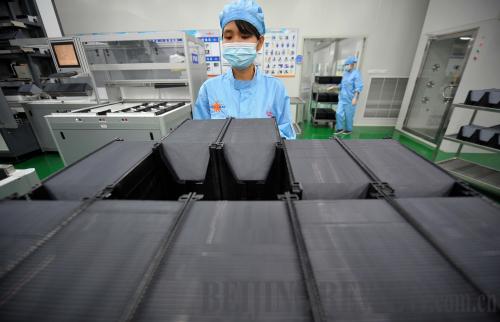Frictions over Renewable Energy
Beijing Review, September 3, 2012 Adjust font size:
China and the United States struggle to cooperate in the pursuit of new energy
Disputes between China and the United States over the renewable energy industry are intensifying.
After the US Department of Commerce launched anti-dumping and countervailing measures against Chinese photovoltaic (PV) energy products in May and wind power products in July, the Chinese Ministry of Commerce (MOFCOM) launched a probe into several US renewable energy projects on August 20. The ruling was that six renewable energy projects from the United States have violated World Trade Organization anti-subsidy rules, distorting international trade.
The MOFCOM announcement said that according to the provisions of Foreign Trade Barriers Investigation Rules, the ministry will take relevant measures in accordance with the law, requiring the United States to cancel the investigations that are inconsistent with WTO agreements and give fair treatment to renewable energy products imported from China.
For China, this may be a powerless response. But insiders are worried that disputes between China and the United States over the renewable energy industry may harm the two sides' healthy cooperation in the sector and have a negative impact on the world's new energy development.
A trade war?
On October 19, 2011, six US solar panel manufacturers filed a complaint with the US Department of Commerce and the US International Trade Commission, accusing Chinese solar companies of receiving subsidies from the Chinese Government and selling panels in the US market at prices below their costs. On November 10, 2011, the US Department of Commerce launched anti-dumping and countervailing investigations on Chinese PV companies, marking the beginning of frictions between China and the United States over renewable energy products. Currently, China is the world's largest manufacturer of PV products, with 10 percent of its solar cells exported to the United States and 80 percent to Europe.
In January this year, the United States expanded the trade dispute from solar power to wind power products. The US Department of Commerce and the US International Trade Commission announced on January 19 anti-dumping and countervailing investigations on utility-scale wind tower products imported from China and Viet Nam.
The price of the wind tower accounts for about 20 percent of that of the finished wind turbine. Because the wind tower is mainly made of steel, many steel-producing companies started manufacturing wind towers, which has resulted in excess production capacity for Chinese wind tower manufacturers and low prices of the product. Since last year, wind towers manufactured by China and Viet Nam have occupied one fourth of the US market.
On May 17, the US Department of Commerce imposed preliminary anti-dumping duties ranging from 31.14 percent to 249.96 percent on Chinese solar cell manufacturing companies and backdated the imposition to 90 days prior.
Suntech Power and Trina Solar face tariffs of 31.22 percent and 31.14 percent respectively. Yingli Solar and other companies that responded to the complaint were hit with a duty of 31.18 percent, and other companies that did not respond to the complaint were charged with a duty of 249.96 percent. If the decision remains unchanged, this will be the first time that Chinese companies are charged with such high tariffs as punishment.
On July 27, the US Department of Commerce announced the preliminary results of the anti-dumping and countervailing investigations on Chinese utility-scale wind towers and imposed duties of 30.93 percent and 20.85 percent on Chengxi Shipyard Co. and Titan Wind Energy, respectively. All other Chinese manufacturers could be hit with duties of between 26.25 percent and 72.69 percent.
The US Department of Commerce will set final anti-dumping and countervailing duties on PV products by this October, and the US International Trade Commission is expected to make a final decision on duties imposed on PV products by this November and on wind towers by the end of this year.
|
|
|
A worker at Yingli Solar in Hainan Province processes silicon chips on August 22.[Beijing Review] |



